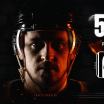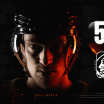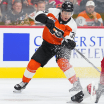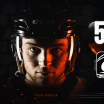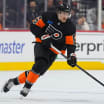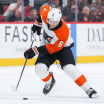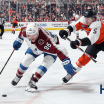The Sultan of the Slot: Tim Kerr
In January of 1980, on the advice of scout Eric Colville, Flyers GM Keith Allen offered undrafted free agent Tim Kerr an NHL contract
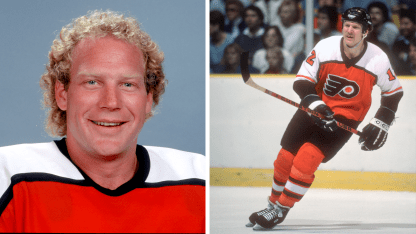
After a short stay with the Maine Mariners at the end of the 1979-80 season, Kerr joined the Philadelphia Flyers for their 1980-81 training camp. Flyers coach Pat Quinn was immediately impressed by Kerr's soft touch around the net. Quinn discovered that Kerr had a very quick release and an uncanny ability to come up with loose pucks.
Kerr's skills immediately proved to be better than advertised. Although he was by no means a speed demon, Kerr was not a plodder, either, once he got his powerful legs churning. He also was extremely difficult to separate from the puck once he got it in deep. There was a lot of goal scoring potential. Kerr also benefited from his versatility. Able to play both center and wing, he offered the team some flexibility with their forward combinations.
Kerr did not get a lot of ice time in his rookie and sophomore seasons. He primarily played on the third or fourth line at even strength and saw secondary power play duty (although he sometimes moved up to the top unit). Right from the start, though, there were glimpses of the scoring machine that would emerge a few years down the road.
Kerr's greatest early-career thrill came on the same night that Bobby Clarke scored his 1,000th career point. Playing in front of his parents, Kerr torched the Boston Bruins for his first career hat trick. Kerr went on to score a very respectable 22 goals in his rookie year, 7 of which were game winners. He followed that up with 21 goals and 51 points his second year.
Unfortunately, Kerr was unlucky with injuries. In his first two seasons, he missed a combined 31 games with a pair of serious knee injuries. In his third season, Kerr suffered a broken leg and was limited to a mere 24 games (in which he scored 11 goals and added 8 helpers).
In 1983-84, Kerr finally had his breakthrough. He emerged as one of the NHL's best goal scorers, particularly on the power play. Given extensive time on the man advantage by coach Bob McCammon, Kerr responded with 54 goals and 93 points. He found his niche by camping out in the slot, deflecting pucks and using his quick release to pump rebounds and quick centering feeds past goalies.
Kerr also had a very under rated slapshot and even a good backhand. Kerr could score goals from any angle and was especially good at scoring from his knees or stomach after being knocked to the ice. Although most of his goals came within five feet of the net, Kerr could also overpower a goalie from long range.
By the end of Kerr's 1983-84 season, opposing defensemen had come to dread the thought of task of trying to move the oak tree-like Kerr from the slot. Cross-checks, slashes, and bearhugs didn't seem to phase him. Taking him out of the play legally was almost out of the question. Once Kerr was cinched in with the puck down low, it was virtually impossible to stop him from doing whatever he wanted to do.
After Clarke retired as a player to become the Flyers new General Manager, he openly questioned whether Kerr had the desire and work ethic to duplicate his totals from the just-completed season. Said Clarke later, "The worry and the question was would he work hard enough?"
At a contract impasse with the Flyers after his 54-goal season, Kerr publicly requested a trade during the summer of 1984. Softening his negotiating tactic, Clarke convinced Kerr to re-consider. The two sides eventually compromised on a new deal. It turned out to be one of the best trades the Flyers never made.
The 1984-85 season marked a major turning point in Kerr's career. It was the year that he finally shook off the label of being anything other than a highly competitive player. He also emerged as more of a complete player.
New head coach, "Iron" Mike Keenan and assistant coach, E.J. McGuire, insisted that Kerr work on his all-around game, particularly his defensive play. They found him to be very receptive to their coaching. Said McGuire, "I knew that the goals would come for him but it was his ability to do the unglamorous things that had us pleased." Although Kerr would never be a Selke Trophy candidate, he became respectable in his own end of the ice, especially when the game was on the line. He also became more consistent in doing all the little things right; such as getting the puck in deep when it was time for a line change.
Kerr was the biggest gun of the underrated attack that led the Flyers to the 1985 Stanley Cup Finals.
When Kerr got on a roll, the goals came in bushels. In the regular season, he once again found the net 54 times. In the post-season, Kerr stepped up his game even further. He ripped home 10 goals in 12 games. It was amazing that Kerr even dressed for the playoffs at all. After suffering a serious late season knee ligament sprain that knocked him out of action for four games, Kerr returned to the lineup, wearing a heavy knee brace.
His return paid huge dividends in opening round series against the Rangers. In the series-clinching game, Kerr singlehandedly turned a 3-2 deficit into a 6-3 lead. In an incredible 8 minute and 16 second span, Kerr ripped apart Rangers goalie Glen Hanlon for four consecutive goals. The Flyers held on to win and advance beyond the first round for the first time since the 1979-80 season. He was also a tower of strength in the second round of the playoffs, as the Flyers knocked off the Islanders in 5 games.
Unfortunately, Kerr's knee gave out on him again in game one of the conference finals against Quebec. He was feared lost for the playoffs. Somehow, though, he managed to suit up for game one of the Stanley Cup Finals. He assisted on the first goal of the game, scored by Ilkka Sinisalo.
Later, Kerr added an insurance goal of his own. In Game Two, which was won 3-1 by Edmonton, Kerr tied the game at 1-1 in the second period before the Oilers went ahead to stay. By game 3, though, Kerr's unstable knee would barely allow him to stand, let alone skate. Kerr tried to play but after a few shifts had to leave the game. He was a frustrated spectator as the powerhouse Oilers went on to close out the series in 5 games.
Kerr worked out hard to rehab the knee in the offseason and reported to camp in great condition, although there were still concerns about the long-term stability of both of his knees.
The 1985-86 season, marred by the death of Pelle Lindbergh and a shocking first round playoff exit, proved to be an emotionally jarring but statistically impressive campaign for the Flyers.
The Flyers, posting 110 points, were runners-up to Edmonton for the top record in the NHL before bowing out in the first round of the playoffs to the superior goaltending of Vezina Trophy winner John Vanbiesbrouck and a surprising resourceful New York Rangers squad (who had only 78 regular season points and were prohibitive underdogs coming into the series).
Even without Lindbergh, the Flyers had a powerhouse team. Especially fearsome was the Flyers power play, with Mark Howe quarterbacking at the point, rookie Pelle Eklund showing extraordinary playmaking ability, and a trio of excellent finishers in Kerr, Brian Propp, and Ilkka Sinisalo. Kerr notched 58 goals in 1985-86, an NHL record 34 of which came on the power play.
In the Flyers' abbreviated playoff run, Kerr added 3 goals and 3 assists in 5 games. Although bitterly disappointed by the abrupt end to the season, Kerr was glad that he knees held up sufficiently to play 76 games in the regular season and all 5 matches in the playoffs.
The next season, 1986-87, would be the bittersweet culmination of the Mike Keenan era Flyers and would be both the high point and the beginning of the end of Tim Kerr's career.
The Flyers, despite earning 10 fewer regular season points than the previous season, were once again the best in the Eastern Conference and runner up to Edmonton for the best record in the NHL. For the first and only time of his NHL career, Kerr ranked among the league's top 10 point-scorers.
Once again tallying 58 goals (topping the 50 goal plateau for the fourth consecutive year), Kerr finished with 95 points, good for a tie with Ray Bourque for 10th in points that season. Although Kerr was still a quiet guy who preferred to lead by example, the courageous way he shrugged off considerable pain in both knees and his left shoulder to go out and score another boatload of goals was an inspiration to every player in the lockerroom.
The late Peter Zezel said of Kerr, "if Timmy can go out there and play like that, none of the rest of us has an excuse to slack off, no matter how bad you think you feel."
Secure in his status as one of the NHL's premier snipers and basking in the respect and admiration of his teammates, Kerr was happy in both his professional and personal life. On November 23, 1986, he married his fiancee, Kathy Anzaldo. The couple bought a home in Avalon, New Jersey.
In the playoffs, Vezina and Conn Smythe Trophy winning rookie goalie Ron Hextall, spearheaded a magical run to the finals.
Throughout the playoffs, the Flyers suffered casualties to many of their most important players: Dave Poulin, Brad McCrimmon, Ilkka Sinisalo, Mark Howe, and Kerr were all either playing with significant injuries or, in Kerr's case, forced out of the lineup altogether. Kerr tried to play with a separated left shoulder and, for a time, managed to succeed. He popped 8 goals in the Flyers first 12 playoff games.
The pain finally got to be too much even for Kerr. The shoulder gave out. Kerr was a spectator as the Flyers polished off the Islanders in the conference finals and then took the Oilers to the seven game limit in the Finals. Just as in 1985, Kerr's body betrayed him at the most inopportune time.
The worst was yet to come for Kerr. Over the summer, Dr. John Gregg cleaned out the damage in Kerr's left shoulder and inserted a surgical pin to hold the shoulder joint in place. The pin came loose and the shoulder separated again. Another pin was inserted. This one became infected and had to be removed.
Diligently, Kerr worked out under the auspices of Flyers strength and conditioning instructor Pat Croce and, at the invitation of Mike Keenan, appeared behind the Flyers bench for a few games, rather than sitting up in the pressbox. When the second setback occurred, Kerr feared that he was becoming a distraction to the team.
Kerr politely removed himself from the locker room and went back alone to work with Croce and eventually to start skating on his own. Finally, on March 10, 1988, Kerr took to the ice again for the Flyers. After just two games, however, stabbing pain returned in his shoulder.
Once again, Kerr was forced to the sidelines, working on a revised conditioning program with Croce. Although the pain did not go away, Kerr managed to return in time to finish up the season, and even score a hat trick against the Winnipeg Jets. The Flyers lost to the Washington Capitals in the first round of the playoffs. Kerr scored a go-ahead goal in game 7 but his team was unable to hold the lead.
After the '87-88 season, Keenan was fired as head coach and replaced by Paul Holmgren. The team slogged through a mediocre regular season (80 points, their lowest total since 1971-72) but made a surprise trip to the Wales Conference Finals.
Combating his bad shoulder and still-aching knees with a combination of strengthening exercises, ice, anti-inflammation medication, and aspirin, Kerr managed to dress in all but 12 games. He came within a whisker of his fifth 50 goal season, settling for "just" 48.
The playoffs saw an all-too-familiar scenario play out for Kerr. He stepped up his scoring even further and was a major force in the Flyers first round series victory over Washington and then matched Mario Lemieux goal for goal in the second round.
In the 7th game of the Penguins series, however, Kerr's thumb was broken by a slash from Jim Johnson. After notching 14 goals in 13 games, Kerr could do little to help in the Wales Conference Finals. Although he suited up and gave it his best effort, he could barely grip a stick, let alone fire a puck past Patrick Roy. The Flyers lost in six games and Kerr scored but one goal in the series.
Kerr took home his first and only piece of NHL hardware when he was named the 1988-89 winner of the Bill Masterton Trophy (awarded for perseverance and dedication to hockey). The quiet, unassuming goal-scoring machine with the superhuman pain tolerance finally had his moment on center stage.
On the night he accepted the award, Kerr said, "This was the most satisfying season of my career."



